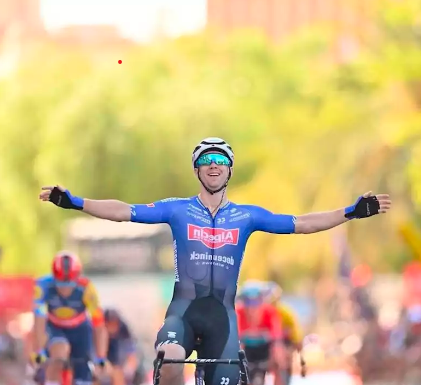http://autoxmoto.comKaden Groves Takes Flight: A Sprinter’s Solo Triumph on Tour de France Stage 20 in the Heart of the Jura
Stage 20 of the 2025 Tour de France delivered an unexpected triumph as sprinter Kaden Groves launched a perfectly timed solo attack to win in the Jura mountains. Known for his sprinting prowess, Groves defied expectations on a stage designed for puncheurs, navigating rain-soaked roads and chaotic breakaway dynamics to secure his first Tour de France stage win. His tactical intelligence and resilience against GC contenders and breakaway specialists highlighted the growing versatility of modern sprinters. Meanwhile, Australian compatriot Harry Sweeny’s valiant solo effort and Jordan Jegat’s climb into the top 10 GC standings added depth to a day defined by unpredictability and aggressive racing. Groves’ win redefined what it means to be a sprinter on the world’s biggest cycling stage.
#KadenGroves #TourdeFrance #Stage20 #SoloVictory #CyclingNews #JuraMountains #HarrySweeny #AustralianCycling #Breakaway #ProCycling
Professional cycling often produces moments that defy conventional wisdom and challenge preconceived notions about rider capabilities. Stage 20 of the Tour de France delivered exactly this type of surprise, as Australian sprinter Kaden Groves demonstrated that speed specialists can excel far beyond their traditional terrain. His solo victory through the challenging Jura mountains rewrote the script for what many expected to be a stage dominated by puncheurs and breakaway specialists.
The beauty of cycling lies in its unpredictability, where tactical acumen and perfect timing can overcome physical disadvantages. Groves’ triumph represents more than just another stage victory; it embodies the spirit of opportunistic racing that makes the Tour de France compelling for riders and spectators alike. His ability to recognize the perfect moment to attack and sustain that effort to the finish line demonstrated the tactical intelligence that separates good riders from great champions.
This stage will be remembered not just for its winner, but for the way it unfolded—a perfect storm of challenging terrain, difficult weather conditions, and tactical maneuvering that created the ideal scenario for an unexpected hero to emerge.
Stage 20: A Rugged Course with High Expectations
The Jura Challenges: A Stage Set for Puncheurs
The route through the Jura mountains presented a profile that seemed tailor-made for riders who specialize in rolling terrain and short, punchy climbs. The parcours featured several notable ascents including the Côte de la Croix de la Serra, Côte de Thésy, and Côte de Longeville, each offering opportunities for attacks and selection among the peloton.
These climbs, while not categorized as major mountain passes, possessed the characteristics that typically favor riders with explosive power and the ability to accelerate repeatedly on undulating terrain. The rolling nature of the stage meant that pure climbers might struggle with the rhythm, while traditional sprinters would face challenges on the ascending sections.
Weather forecasts added another layer of complexity to the stage, with predictions of rain and potentially difficult wind conditions. These environmental factors historically transform already challenging stages into exercises in bike handling, risk management, and tactical adaptation that can dramatically alter race outcomes.
Pre-stage commentary from riders and directeurs sportifs emphasized the unpredictable nature of the terrain and weather combination. Many predicted that the stage would favor opportunistic riders willing to take calculated risks when conditions created openings for decisive moves.
The Breakaway Hunt: A Tactical Game from the Start
The opening kilometers of Stage 20 witnessed the typical frenetic pace that characterizes stages where multiple teams harbor ambitions for victory. Early attacks came from various quarters as riders attempted to establish the day’s decisive breakaway group before the peloton could organize an effective chase.
Initial moves involved notable riders including Tim Wellens, Matteo Jorgenson, and Anthony Costiou, each representing different team strategies and racing philosophies. These early attempts faced immediate pressure from the peloton, as teams with sprinters and stage ambitions worked to control the situation and influence the composition of any successful break.
The difficulty in forming a stable breakaway group reflected the high level of interest in the stage from multiple teams and rider types. Unlike mountain stages where breakaway formation often occurs relatively quickly, the rolling terrain and stage profile meant that many different riders saw opportunities for success.
The tactical complexity of the early racing demonstrated how modern professional cycling has evolved, with teams employing sophisticated strategies to position their riders advantageously while preventing rivals from gaining decisive advantages through early breakaway moves.
Formation of the Day’s Breakaway: A Group of Thirteen Under Tension
The Unexpected Composition and the Jegat Factor
When the day’s breakaway finally established itself, it contained thirteen riders whose presence together created immediate tactical complications. The group’s composition reflected the diverse range of rider types who saw opportunities on this particular stage profile, from breakaway specialists to riders with general classification aspirations.
The inclusion of Jordan Jegat, sitting eleventh in the general classification, immediately created friction both within the breakaway group and between the break and the chasing peloton. Jegat’s relatively high GC position meant that giving him significant time gaps could impact the overall Tour standings, creating reluctance among both his breakaway companions and the teams controlling the peloton.
Internal discussions within the breakaway group revealed the complex dynamics that emerge when riders with different objectives find themselves working together. Some members, like Velasco and Van den Broek, expressed concerns about allowing Jegat to gain too much time, while others focused primarily on maximizing their own stage victory chances.
These tensions reflected the sophisticated tactical thinking that characterizes modern professional cycling, where riders must constantly balance personal ambitions with group dynamics and broader strategic considerations that extend beyond individual stage results.
Difficult Conditions: Rain Joins the Party
The arrival of rain during the stage added a crucial element that would influence both tactics and outcomes throughout the day. Wet roads transform cycling races by increasing risks, reducing visibility, and requiring more conservative approaches to cornering and descending, all of which can dramatically alter race dynamics.
The challenging conditions led to several incidents, including problems for riders like Schmid and Champoussin, while others like Harry Sweeny demonstrated exceptional bike handling skills in navigating hazardous situations, including a near-miss with a traffic island that could have ended his race prematurely.
Rain effects extended beyond simple safety concerns to impact tactical decisions throughout the peloton and breakaway groups. Riders became more cautious in their positioning and timing of attacks, while teams had to adjust their support strategies to account for increased mechanical risks and potential crashes.
The weather conditions also created psychological pressure, as riders had to maintain focus and decision-making capabilities while dealing with physical discomfort and reduced road conditions that demanded constant attention to bike handling and positioning.
Harry Sweeny’s Heroic Solo Effort
The Australian’s Bold Attack
Harry Sweeny’s decision to launch a solo attack after catching Jordan Jegat represented the type of bold tactical move that often determines stage outcomes in professional cycling. His timing demonstrated excellent race reading ability, as he recognized a moment when group dynamics and positioning created an opportunity for a lone rider to establish a meaningful advantage.
The Australian’s solo effort faced the dual challenges of maintaining pace against the clock while battling deteriorating weather conditions that made every pedal stroke more demanding. His ability to build and maintain a substantial gap over the chasing group showcased both his physical capabilities and mental resilience under pressure.
Recognition of Sweeny’s effort came through his selection as the day’s most combative rider, an honor that acknowledged his willingness to take risks and animate the race even when ultimate victory remained uncertain. This recognition highlighted how professional cycling values aggressive racing that creates spectacle and tactical complexity.
His solo breakaway attempt demonstrated the fine margins that separate success from failure in professional cycling, where riders must commit fully to attacks while knowing that most such efforts ultimately fail to reach the finish line ahead of organized chase groups.
The Chase Group’s Return and Reintegration
The reduction of Sweeny’s advantage and his eventual capture on the Côte de Longeville illustrated how difficult it is to maintain solo breakaways against organized pursuit, particularly when weather conditions demand extra energy for basic bike control and safety considerations.
Despite being caught by the regrouped chase, Sweeny demonstrated remarkable resilience by managing to rejoin the leading group after initially being dropped. This ability to recover from temporary setbacks and continue competing at the highest level exemplified the mental toughness required for success in Grand Tour racing.
Sweeny’s post-race comments revealed the complex emotions that accompany such efforts, combining disappointment at not achieving stage victory with pride in having animated the race and earned recognition for his aggressive tactics. These mixed feelings reflect the reality of professional cycling, where moral victories often accompany tactical defeats.
His experience highlighted how individual efforts can influence race dynamics even when they don’t result in stage victories, creating opportunities for other riders while demonstrating the type of attacking mentality that makes bicycle racing compelling for spectators and participants alike.
A Chaotic Finale and Groves’ Decisive Attack
Crashes and Reduction of the Leading Group
The crash involving Iván Romeo and Romain Grégoire with twenty-one kilometers remaining transformed the stage’s final act by suddenly reducing the leading group’s size and creating new tactical opportunities for the remaining contenders. Such incidents demonstrate how quickly circumstances can change in professional cycling, turning apparent disadvantages into potential advantages.
The crash’s impact extended beyond the immediate victims to affect race dynamics among the surviving breakaway members. Suddenly, instead of managing a larger group with complex tactical considerations, the remaining riders faced a simplified situation with fewer variables but potentially higher stakes for each individual.
The reduction to just Groves, Stewart, and Van den Broek created a more manageable tactical situation where each rider’s strengths and weaknesses became more clearly defined. This simplification often leads to more decisive racing, as riders can more easily calculate their chances and timing for decisive moves.
The incident also highlighted the ever-present risks in professional cycling, where mechanical problems, crashes, and other unforeseen circumstances can instantly eliminate months of preparation and training from consideration in crucial race moments.
The Sprinter’s Masterstroke
Kaden Groves’ decision to attack with sixteen kilometers remaining represented a calculated gamble that perfectly balanced risk and opportunity. His timing caught his companions hesitant, allowing him to establish a gap that would prove decisive in determining the stage outcome.
The hesitation from his rivals demonstrated how quickly tactical situations can shift in cycling’s final kilometers. What appeared to be a manageable group situation suddenly became a chase scenario where coordination among the pursuers became crucial but difficult to achieve with conflicting individual interests.
Groves’ ability to build and maintain his advantage throughout the final kilometers showcased both his tactical intelligence and physical capabilities. Rather than simply relying on traditional sprinter skills, he demonstrated the versatility that characterizes modern professional cycling’s most successful riders.
His growing advantage as the finish line approached confirmed that his attack timing had been perfect, catching his rivals at a moment when they couldn’t respond effectively while he still possessed sufficient energy reserves to sustain his effort to the conclusion.
The Historic Victory and Its Repercussions
Groves’ Celebration and Career Achievement
Kaden Groves’ celebration of his first Tour de France stage victory marked a significant milestone in his professional career and Australian cycling history. His achievement placed him among the 114th different riders to win stages in all three Grand Tours, joining an exclusive group that demonstrates consistent excellence across cycling’s most demanding competitions.
The victory represented more than personal achievement, symbolizing the evolution of modern sprinting and the increased versatility required for success in contemporary professional cycling. Groves’ ability to win on terrain traditionally dominated by different rider types highlighted how the sport continues to evolve and reward adaptability.
His triumph also reflected the strength of Australian cycling development programs and the country’s continued production of world-class riders capable of competing successfully in Europe’s most prestigious races. This success builds on a rich tradition of Australian achievement in international cycling competition.
The emotional significance of achieving a first Tour de France stage victory cannot be understated, as such moments represent the culmination of years of preparation, sacrifice, and dedication to reaching cycling’s highest level of competition.
Impact on General Classification and Team Performance
Jordan Jegat’s advancement to tenth place in the general classification represented a significant achievement for both the rider and his team, demonstrating how breakaway participation can yield multiple benefits beyond stage victory opportunities. His climb up the GC standings rewarded aggressive racing tactics and willingness to take calculated risks.
Team performances throughout the stage highlighted the importance of tactical flexibility and adaptability in modern professional cycling. EF Pro Cycling’s support for their riders exemplified how teams must balance stage ambitions with broader strategic objectives throughout three-week Grand Tours.
Post-race comments from riders like Ben Healy and Neilson Powless provided insights into the tactical thinking and decision-making processes that influenced the stage outcome. These perspectives revealed the complex calculations that riders constantly make regarding positioning, timing, and energy management.
The stage results also demonstrated how individual performances can impact team morale and strategy for remaining race stages, creating momentum that extends beyond immediate tactical considerations to influence broader Tour de France objectives and planning.
Future Perspectives and Stage 20’s Legacy
En Route to Paris: The Grand Finale
The approach to the final stage in Paris carries its own unique challenges and opportunities, with the traditional Champs-Élysées circuit preceded by the climb of Montmartre adding tactical complexity to what is typically considered a ceremonial stage for the general classification and a sprinters’ showcase.
Rider and team objectives for the Tour’s conclusion reflect the diverse goals that motivate participation in cycling’s most prestigious event. While some focus on preserving GC positions, others see final opportunities for stage glory or to complete personal and team objectives established before the race began.
The psychological transition from the challenging mountain and rolling stages to the urban finale requires mental adjustment as riders shift from survival mode to potentially more aggressive tactical thinking, depending on their individual circumstances and remaining objectives.
Planning for the Paris stage involves different considerations than typical road stages, with factors like crowd control, media attention, and ceremonial aspects influencing how teams and riders approach their final Tour de France opportunity.
A One-Day Classic: Lessons in Strategy and Resilience
Stage 20’s development resembled a one-day classic in its combination of challenging terrain, difficult conditions, and tactical complexity that rewarded opportunistic racing over pure physical dominance. This character made it memorable beyond typical Tour de France mountain or sprint stages.
The stage proved that sprinters can succeed on terrain traditionally favoring other rider types, challenging conventional wisdom about specialization in modern professional cycling. Groves’ victory demonstrated how tactical intelligence and perfect timing can overcome apparent physical disadvantages in specific race situations.
The lesson extends beyond individual achievement to highlight how modern cycling rewards versatility and adaptability over narrow specialization. Riders who can perform across diverse terrain types and race situations possess significant advantages in stage race competition.
Stage 20’s legacy will likely influence how riders and teams approach similar future stages, demonstrating the value of aggressive tactics and willingness to take calculated risks when conditions create opportunities for unconventional outcomes in professional cycling’s most demanding competitions.




